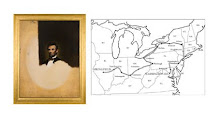Saturday, July 31, 2010
Outside of Syracuse I pick up the Erie Canal towpath once again. The weather was cool in the morning and I can tell I am further north. The forests are filled with aspen and birch trees with white pines intermingling. Just outside of town I came up on 2 horses hitched to a small wagon pulling a flat boat down the canal. The trail I came down prior to this was very narrow and seeing this site made me think I had just missed a Shawnee raiding party on the path.
As I move towards Rome, little did I know that I was heading into the Mohawk Valley and the Oneida Carrying Place. Across the street from my stay is a National monument, Fort Stanwix. This area had tactical importance in the French and Indian War and the Revolution. What amounted to a four way battle for the same realestate and access to the west, ended up dividing the 6 Nations Iroquois and broke their centuries old confederation and peace. Forced to choose alliances, the Oneida sided with the Colonialists and the Mohawk and Seneca sided with the British. To the north, the Huron, who were enemies of the Iroquios, were aligned with the French. Once the British drove the French out of North America, the seeds of the Revolution were set. After the defeat of the British, the treaty with the 6 Nations and the Americans cast the first concept of native sovereignty and established the reservation system. The land deal opened up the canal lands but sowed the seeds of further problems the US would have in dealing with Native Americans. Not that he didn't have enough to do in dealing with a national internal crisis, but Lincoln was also forced to deal with uprisings on the high plains and the Lakota Sioux.
As I move towards Rome, little did I know that I was heading into the Mohawk Valley and the Oneida Carrying Place. Across the street from my stay is a National monument, Fort Stanwix. This area had tactical importance in the French and Indian War and the Revolution. What amounted to a four way battle for the same realestate and access to the west, ended up dividing the 6 Nations Iroquois and broke their centuries old confederation and peace. Forced to choose alliances, the Oneida sided with the Colonialists and the Mohawk and Seneca sided with the British. To the north, the Huron, who were enemies of the Iroquios, were aligned with the French. Once the British drove the French out of North America, the seeds of the Revolution were set. After the defeat of the British, the treaty with the 6 Nations and the Americans cast the first concept of native sovereignty and established the reservation system. The land deal opened up the canal lands but sowed the seeds of further problems the US would have in dealing with Native Americans. Not that he didn't have enough to do in dealing with a national internal crisis, but Lincoln was also forced to deal with uprisings on the high plains and the Lakota Sioux.
Subscribe to:
Post Comments (Atom)






No comments:
Post a Comment